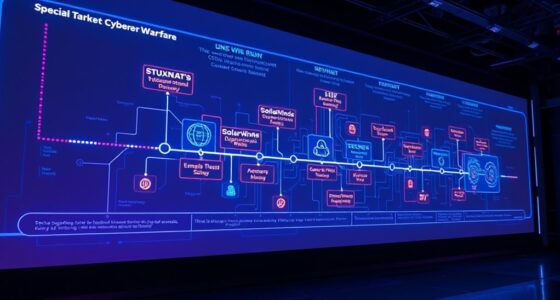Over the decades, industrial espionage has shifted from simple office infiltrations to complex cyberattacks targeting major corporations and governments. Notorious cases include China’s theft of intellectual property from tech giants, the economic espionage during the Cold War, and recent cyber intrusions involving malware and insider threats. These incidents reveal how espionage tactics have become more sophisticated and clandestine. If you continue exploring, you’ll discover how these cases shaped modern security strategies and ongoing challenges in protecting essential information.
Key Takeaways
- Cold War espionage involved covertly stealing military and technological secrets through spies and covert operations.
- Notable cases include the theft of industrial secrets by corporate spies and state-sponsored actors targeting tech companies.
- Techniques evolved from physical infiltration to cyberattacks, malware, and digital data breaches over the decades.
- High-profile incidents like the theft of trade secrets from tech giants highlight increasing sophistication in espionage tactics.
- Global competition drives aggressive espionage efforts, aiming for economic dominance and strategic advantages across industries.

Industrial espionage has evolved markedly over the decades, adapting to technological advances and shifting global power dynamics. You might not realize it, but corporate theft and espionage tactics have become sophisticated tools used by rival companies and nations alike to gain a competitive edge. In the early days, espionage was often carried out through simple methods like infiltrating offices or bribing employees, but today, the tactics have become more complex and clandestine. Cyber spying, hacking, and data breaches are now common ways to steal valuable information, making it harder to detect and more damaging when uncovered.
Modern espionage relies on cyber hacking and data breaches to steal sensitive information.
You may think that corporate theft is limited to physical documents or prototypes, but modern espionage involves digital infiltration on a large scale. State-sponsored actors and organized crime groups frequently target corporations to access trade secrets, proprietary technology, and strategic plans. Espionage tactics have adapted to exploit vulnerabilities in networks, cloud storage, and even employee devices, allowing perpetrators to siphon off sensitive data remotely. This shift means that companies must be constantly vigilant, implementing advanced cybersecurity measures and monitoring for suspicious activity to prevent data leaks.
Throughout history, some notorious cases highlight how these tactics have been employed with devastating effect. For example, during the Cold War, espionage agencies engaged in covert operations to steal military and technological secrets. Fast forward to more recent years, and cases like the theft of intellectual property from tech giants or the infiltration of industrial supply chains demonstrate how corporate theft has become a lucrative enterprise. These incidents often involve sophisticated espionage tactics—using fake identities, malware, or insider accomplices—to bypass security and extract critical information.
You should also be aware that the stakes are higher than ever, with global competition fueling these clandestine activities. Countries and corporations invest heavily in espionage capabilities, knowing that the loss of a key patent or secret technology can mean the difference between dominance and obsolescence. As a result, industrial espionage isn’t just about stealing secrets; it’s about securing economic and strategic advantages that shape international power. Additionally, the evolution of high-tech espionage tools has further increased the complexity and danger of these activities, requiring organizations to stay ahead of increasingly sophisticated threats.
In essence, understanding the evolution of industrial espionage through the decades reveals a pattern: as detection methods improve, so do the techniques used to bypass them. You need to stay informed about espionage tactics and remain vigilant, because in today’s interconnected world, the threat of corporate theft is more pervasive and sophisticated than ever before.
Frequently Asked Questions
What Are the Most Common Methods Used in Industrial Espionage?
You might wonder what methods are common in industrial espionage. Typically, attackers use corporate sabotage, like damaging systems or leaking information, and insider threats, where employees or partners secretly share sensitive data. They may also employ hacking, phishing, or physical theft to access valuable secrets. These tactics aim to steal intellectual property or trade secrets, making organizations vulnerable to financial loss and competitive disadvantages. Staying vigilant is essential to prevent such threats.
How Do Companies Protect Themselves From Espionage?
Imagine your company’s secrets under siege—you need strong defenses. You protect yourself by enforcing strict corporate secrecy policies, ensuring sensitive info stays secure. Regular employee training on insider threats can reveal vulnerabilities and prevent leaks. Implementing advanced cybersecurity measures keeps digital assets safe. Keep a close eye on access controls and monitor unusual activity. Staying vigilant and proactive is your best weapon against espionage, safeguarding your innovation and competitive edge.
What Legal Consequences Do Spies Face Today?
When you’re caught engaging in espionage today, you face serious legal consequences, including hefty fines and imprisonment. Courts take intellectual property theft very seriously, especially when cyber breaches compromise sensitive data. Companies strengthen cybersecurity strategies to deter spies, but if you’re caught, authorities will pursue charges like theft, fraud, or conspiracy. These legal actions serve to protect innovation and maintain fair competition in the modern business landscape.
Which Industries Are Most Targeted by Espionage?
Imagine a hacker in a trench coat sneaking into a high-tech lab—this paints a vivid picture of how certain industries remain targeted. You should know that industries like tech, pharmaceuticals, aerospace, and energy are most vulnerable to espionage. These sectors face industry-specific threats and corporate vulnerabilities, making them prime targets for spies seeking valuable secrets. Staying vigilant helps protect your organization’s sensitive information from these persistent threats.
How Has Technology Evolved to Prevent Industrial Espionage?
You might notice that technology has substantially evolved to prevent industrial espionage through improved cybersecurity advancements and sophisticated counterintelligence techniques. You’re protected more effectively now with encryption, intrusion detection systems, and secure communication channels. Organizations actively monitor for suspicious activities, using AI and machine learning to identify threats early. These advancements help you safeguard sensitive data, making it harder for spies to penetrate your defenses and ensuring your innovations stay protected.
Conclusion
As you’ve seen, industrial espionage has evolved but remains just as dangerous. From secret leaks to high-tech hacking, the stakes are higher than ever. Do you think companies are doing enough to protect their secrets, or is it only a matter of time before another scandal unfolds? Staying vigilant and innovative in security measures is your best defense. After all, in this game of secrets, can you really afford to stay unaware?









